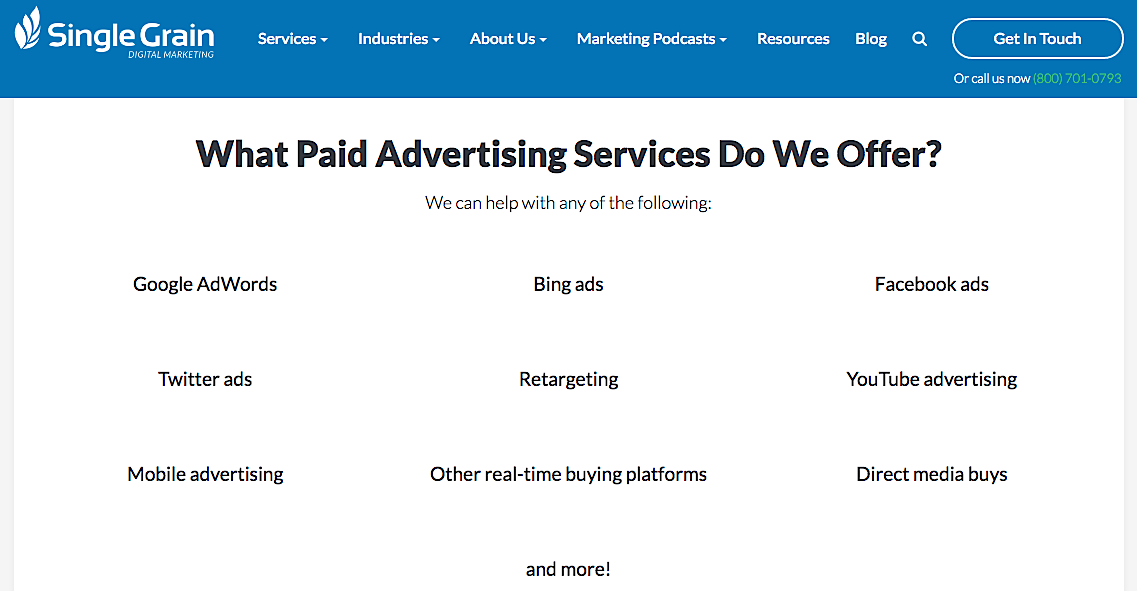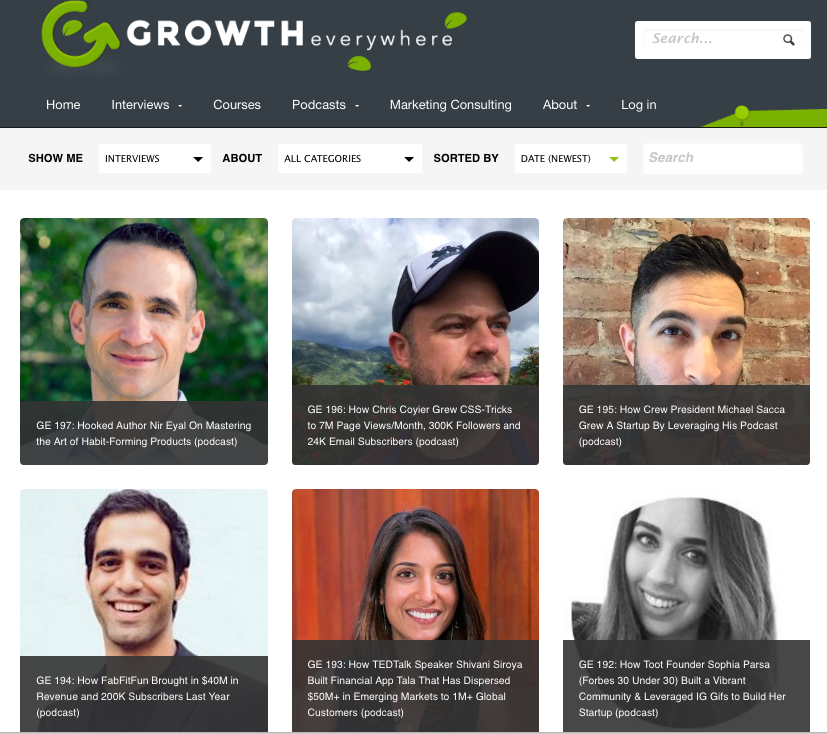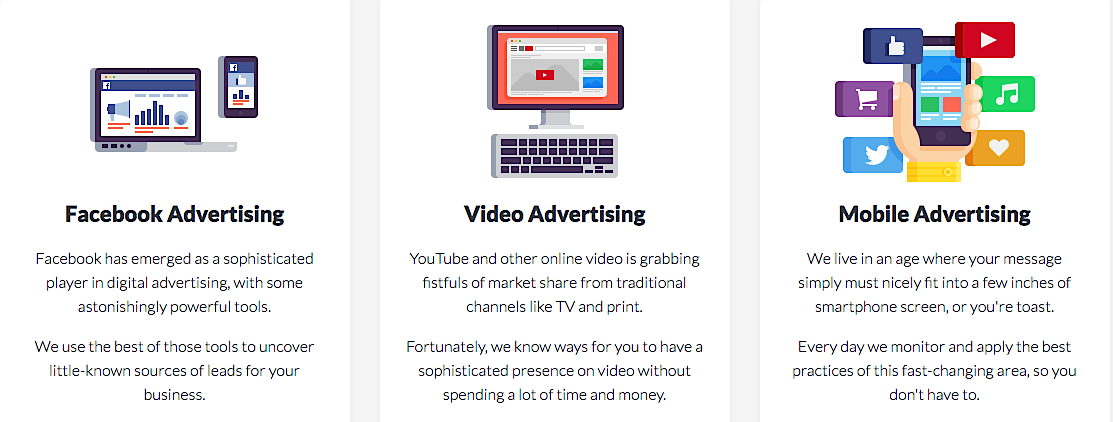Today I’m going to talk about where you should start your first marketing campaign.
Most people think that if they’re marketing for B2B they should just copy what all the other B2B guys are doing. Or if they’re B2C they should just copy what all the other B2C guys are doing. Well, what worked for someone else won’t necessarily work for you, even if they’re in your same exact space.
When Neil had his first real business, which was an ad agency, he was trying to figure out how to grow it and was looking for marketing channels to leverage and he ended up just copying a lot of his competitors. And you know what? He copied a lot of his competitors’ marketing efforts to a tee and it did not work out well for him. In some cases his ROI was negative.
How to Decide Where to Start Your Marketing Efforts
Figuring out where to start your marketing campaign is sort of like throwing spaghetti at the wall. You take a lot of different marketing channels and strategies, you throw ’em at the wall, and whatever sticks is what you should focus on. Maybe you start with paid ads, SEO, Facebook ads, social media marketing, content marketing, etc. Whatever you start with, you want to keep your experiments short and sweet.
Learn More: Effective SEO Techniques that Work in 2017

Figure out what’s not working out and put it on the backburner. Figure out what is working, and what has the most potential (output) with the least work (input). Then double down on that. Only after you’ve mastered this first channel and you’re seeing great ROI should you add another channel into the mix.
If the second thing that stuck on the wall like spaghetti was content marketing, then the second thing I would leverage is content marketing. I’d keep picking and investing in winners, and only after all those channels are streamlined and optimized will I pick up the channels I left on the backburner and see if I can’t do something really creative there. كيف تربح المال من الإنترنت
Learn More: How to Create a Content Marketing Strategy if You Are a Beginner
Start with “Hand-to-Hand” Guerrilla Marketing
Another really important thing to keep in mind is that if you’re guerrilla marketing in the trenches, you aren’t doing anything wrong. I’ve interviewed over 200 entrepreneurs on Growth Everywhere and asked each one of them, “How do you go about acquiring the first 100 or 1,000 customers?” Almost always, without fail, the answer is hand-to-hand combat. موقع المراهنات على المباريات It’s going out there knocking on doors, cold-calling and e-mailing people directly.

The reason a lot of companies do this kind of guerrilla marketing at the start is because your first 100 customers will determine your first 1,000 customers, and your first 1,000 customers will determine your first 10,000 customers. So if you have the wrong 100 customers to start with, it screws everything up.
For example, if you picked the wrong first 100 customers and they churn and you’re not making that much revenue and they’re not satisfied with your product, those initial customers are also generating negative press and reviews at the same time. You’re pretty much screwed, because those people don’t just have a bad taste in their mouth.
Related Content: The Genius Acquisition Plan import.io Used to Acquire 10,000 Customers [podcast]
Nowadays, with social media, Facebook, Twitter, Instagram, etc. people are able to tell the whole word, “Hey, I tried this company and it sucks.” Once you have that kind of press going for you, it’s really hard to rebound from it, especially during the early days.
This kind of nose-to-the-ground guerrilla marketing is also the best way to test and validate new product concepts. For example, we’re developing a Slack bot, and instead of paying a developer 15, 30, 45 grand to develop this one feature, we’re first seeing if people actually want it. That is, we’re reaching out to people individually and sending them the beta version manually. And people are raising their hands and saying, “Hey, I would actually pay for this.”
So we’re starting those 1-on-1 conversions and we’re actually getting people to commit a certain amount ahead of time. We’re getting dollars in the door without even having a product yet.
The Lowest Barrier-to-Entry Marketing Channels
Facebook is one of the strongest acquisition channels; the minimum you could be doing is retargeting people that are coming back to your site. You could also write a few blog posts, call it an advertorial about the top mistakes people shouldn’t be making, and you’re driving Facebook traffic to that. Seeing how people respond to that is a quick and easy way of testing things out when you’re first starting.
You also need to analyze your current situation. As a company, what is your cash flow? Do you need money today? Do you need it tomorrow? Do you need it a month from now? A year from now? What’s your runway? If you weren’t making any money, if you have X dollars in your bank account, how long will you last?
If you have to figure out how to make money in the next week or month or else you’re going to shut down, you don’t want to invest too heavily in strategies like SEO or content marketing, or even social media marketing, because they take so long to work. Building up a Facebook channel, or Twitter channel, or getting rankings on Google, it’s a lot of work.
If that’s the situation you’re in, you should look at paid advertising. It could be Google Adwords, Facebook advertising, Twitter advertising, or LinkedIn advertising, but you have to look at your cash situation.
If you’re one of those entrepreneurs who is great at raising money and you raise $30 million, then you should start focusing on the longer-term strategies while testing out paid advertising at the same time.
Related Content: How Canva Grew From 1K to 10M Users Without Paid Advertising (podcast)
Avoid These Marketing Strategies When Starting Out
If you’re just starting out, it wouldn’t make a lot of sense to go out there and try to build affiliate partnerships. There’s a sales cycle to it and when you’re working with other people they don’t necessarily have that incentive to work directly with you; they’re in it for themselves at the end of the day.
Another strategy I would avoid if you’re starting off would be content marketing, although I love it to death. If you don’t know exactly who you’re targeting and you start creating content for the wrong audience, you’re shit out of luck. شرح 1xbet That means all the posts that you’ve created won’t do you any good. Once you get your first 100 customers manually or through whatever channel you want, once you figure out exactly who they are, then you can create content.
Identify Your Buyer Personas as Soon as Possible
At Kissmetrics, Neil’s ideal customer was an e-commerce company or a subscription-based SaaS company that did over $10 million per year in revenue and had a VP of marketing or a director of marketing.
If the companies were smaller than $10 million and they didn’t have a VP of marketing or a director of marketing, Neil found that they not only didn’t pay him well, they also had a much shorter lifecycle.
But clients above $10 million understood that it was really important to maximize their use of Neil’s services and the Kissmetrics product. So not only would they sign up for the product, they would also put resources behind it internally to get it up and running.
Learn More: The Complete Guide to Developing and Using Buyer Personas
In Summary
The key takeaways here are focus on hand-to-hand combat, pick the channels that you think are going to provide the best return, throw things against the wall and then focus on the channels that stick. Then, once you start doing guerrilla marketing, you’ll be able to figure out who your target personas are.
That’s going to give you the confidence you need to really sell your product or service, and scale it up into the big leagues.
This post was adapted from Marketing School, a 10-minute daily podcast in which Neil Patel and Eric Siu teach you real-life marketing strategies and tactics from their own experience to help you find success in any marketing capacity. Listen to the podcast version of this post below:








